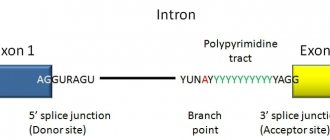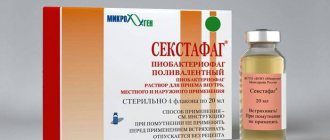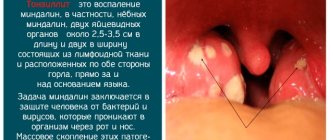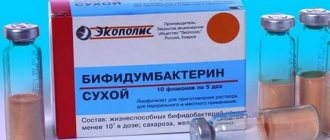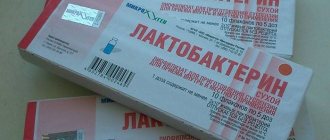≡ Home → Cervix → Erosion →
One of the popular drugs used to treat cervical erosion is the drug Solkovagin, and reviews of patients who have used this medicine confirm its effectiveness.
Solkovagin is a Swiss drug. It is used in gynecology for the local treatment of pathological processes on the surface of the cervix. It belongs to the group of chemicals with cauterizing properties, is accessible and easy to use.
It should be noted that the drugs previously used to treat erosion were also attractive for their simplicity and accessibility. But as it turned out later, they acted superficially, required repeated use and caused burns not only to pathologically changed areas, but also to the entire cervical surface and even the walls of the vagina, leading to scarring. The new generation drug Solkovagin was synthesized taking into account the shortcomings and experience of using previous drugs.
Composition, form and packaging of the medicine
In what packaging does the drug “Solkovagin” come to pharmacies? Instructions for use (the price of this drug will be indicated below) are included in a cardboard box, which contains two bottles of the drug and additional stoppers.
This medication is available in the form of a solution intended for topical use. The active ingredients of the drug are acetic acid, oxalic acid dihydrate, nitric acid and zinc nitrate hexahydrate. Distilled water is used as an auxiliary ingredient.
Solkovagin
Active substance:
Pharmgroup:
Other miscellaneous means
Average price in pharmacies
| Name | Manufacturer | average price |
| Solkovagin 0.5 n2 bottle solution | MEDA PHARMA | 1987.00 |
Application area:Abdominal surgery Adenomectomy Balloon coronary angioplasty Vaginal hysterectomy Corona bypass Interventions on the vagina and cervix Bladder interventions Intervention in the oral cavity Restorative and reconstructive operations Hand hygiene of medical personnel Gynecological surgery Gynecological interventions Gynecological surgeries Hypovolemic shock during surgery Disinfection of purulent wounds Disinfection of wound edges Diagnostic interventions Diagnostic procedures Diathermocoagulation of the cervix Long surgical operations Benign lesion of the superficial tissues of the cervix Replacing fistula catheters Infection during orthopedic surgery Artificial heart valve Cystectomy Short-term outpatient surgery Short-term operations Short-term surgical procedures Cricothyroidotomy Blood loss during surgery Bleeding during surgery and in the postoperative period Culdocentesis Laser coagulation Laser coagulation Laser coagulation of the retina Laparoscopy Laparoscopy in gynecology CSF fistula Minor gynecological operations Minor surgical interventions Mastectomy and subsequent plastic surgery Mediastinotomy Microsurgical operations on the ear Mucogingival surgeries Stitching Minor surgeries Neurosurgical operation Immobilization of the eyeball in ophthalmic surgery Orchiectomy Complications after tooth extraction Pancreatectomy Pericardectomy Rehabilitation period after surgery The period of convalescence after surgical interventions Percutaneous transluminal coronary angioplasty Pleural thoracentesis Pneumonia postoperative and post-traumatic Preparing for surgical procedures Preparing for surgery Preparing the surgeon's hands before surgery Preparing the colon for surgery Polyp of the cervical canal Postoperative aspiration pneumonia during neurosurgical and thoracic operations Postoperative nausea Postoperative bleeding Postoperative granuloma Postoperative shock Early postoperative period Myocardial revascularization Resection of the apex of the tooth root Gastric resection Bowel resection Resection of the uterus Liver resection Small bowel resection Resection of part of the stomach Reocclusion of the operated vessel Bonding tissue during surgery Removing stitches Condition after eye surgery Condition after surgery Condition after surgical interventions in the nasal cavity Condition after gastrectomy Condition after resection of the small intestine Condition after tonsillectomy Condition after removal of the duodenum Condition after phlebectomy Vascular surgery Splenectomy Sterilization of surgical instruments Sterilization of surgical instruments Sternotomy Dental operations Dental intervention on periodontal tissues Strumectomy Tonsillectomy Thoracic surgery Thoracic operations Total gastrectomy Transdermal intravascular coronary angioplasty Transurethral resection Turbinectomy Removal of a tooth |
Pharmacological characteristics
What is Solkovagin solution? The instructions for use indicate that this is a local necrotizing agent.
The active components of this drug are specially designed for the treatment of benign lesions of the epithelial tissues of the cervix. The effect of the drug on different cells depends on their type.
When the solution is used locally, devitalization of columnar epithelial cells occurs. This process is carried out due to the instant denaturation of proteins, which is caused by a chemical reaction.
Areas of transformation and sites of cervical ectopia, as well as areas of erosive lesions, are predisposed to the devitalizing effect of the drug. In this case, intact mucous membranes practically do not react to the drug and are not damaged.
How does Solkovagin solution work? The instructions for use indicate that this medication leads to a change in the color of the tissues with which it came into contact (to yellow-white or gray-white). In this case, the devitalization epithelium promotes the slow formation of a peeling protective layer. In turn, a new layer of flat cells is formed under it.
Composition of the drug
The drug belongs to the group of necrotizing agents that are intended for topical use. "Solkovagin" contains acids:
- nitrogen;
- vinegar;
- oxalic acid (dihydrate).
The medicine also contains Zn nitrate. These microelements ensure the elimination of dead skin cells in the area of application of the medication. When the cervical canal is in optimal condition, its walls are covered with cylindrical epithelial tissues. And the vaginal part of the cervix is lined with multilayered flat tissues.
Under the influence of many factors, cylindrical cells can freely move into part of the multilayer epithelial tissues and are located in the cervical region. This phenomenon is called epithelial dystopia or pseudo-erosion. This phenomenon requires cauterization. Without proper treatment, such an area of complete or partially destroyed surface of the cervix can pick up microbes. As a result, this infection can develop into a malignant tumor. Treatment with Solkovagin makes the displaced tissue and its cells non-viable. However, this medicine does not affect the more resistant stratified epithelium. Therefore, as a result of applying “Solkovagina” for therapeutic purposes to the affected tissue, the damaged area is preserved and then replaced by normal cervical epithelium.
Indications for use
For what purpose can Solkovagin solution be used? Instructions for use, reviews from experts say that this medication is actively used in gynecological practice for benign lesions of the epithelial tissues of the cervix. Thus, it is used for:
- polyps of the cervical canal (without any endometrial pathology);
- nabothian cyst (including after opening);
- cervical ectopia;
- in the transformation zone;
- postoperative granuloma.
To cauterize or not to cauterize erosion with Solkovagin?
It is very important to decide in which case chemical coagulation of the cervix is indicated. If we are talking about ectopia (with a normal cytological smear and a good colposcopic picture), then no treatment is required. Dynamic observation and annual visits to the gynecologist are enough. And, on the contrary, with deep tissue damage, Solkovagin will not cope with the problem, so the defect will have to be cauterized with a laser, radio waves or another method.
Chemical coagulation is a fairly gentle type of therapy that can be a good alternative for women who are afraid of surgical methods of treating pathology. However, it is worth remembering that this drug is prescribed mainly to young nulliparous girls, provided that the size of the lesion in the cervix is less than 10 mm.
Another question is if this is a complicated erosion, and after colposcopy deviations from the norm are found. In this case, the doctor will suggest a biopsy of the cervix and only after excluding malignant tissue lesions will he give recommendations for treating erosion by any available method.
Interesting video about different types of “cauterization” of erosion, including chemical coagulation
The drug "Solkovagin": method of administration and dosage
How should the medication in question be used? This product is intended for topical use only. It is used to cauterize benign tumors.
The procedure should be performed only by a gynecologist who has extensive experience in treating such pathologies.
Only the affected area is treated with the solution. In this case, contact with the skin of the genital organs and vaginal epithelium should be avoided.
How to use Solkovagin solution? The instructions for use state that before starting the treatment procedure, you need to clean the cervix of secretions using a regular cotton swab. Next, it is treated with a 3% acetic acid solution. This will allow you to clearly identify the affected area.
The cauterization procedure should be carried out with extreme caution. To do this, a cotton swab is soaked in a medicinal solution and then fixed on a wooden stick. The affected areas are treated after 1-2 minutes.
Treatment of benign tumors is carried out on an outpatient basis. At the same time, there are no restrictions on water procedures and sexual activity.
How much does Solkovagin treatment cost in different clinics?
At the antenatal clinic at the place of residence to which the patient is attached, erosion will be treated free of charge (if you have a compulsory medical insurance policy). You will only have to pay for the drug itself or buy the medicine at the pharmacy with a doctor’s prescription. The cost of Solkovagin is relatively low and ranges from 600 to 1,000 rubles.
If a patient prefers to be treated for a fee, then she should know that the price of the procedure depends on the prestige of the clinic. In this case, in addition to the cost of the drug, you will need to additionally pay for the doctor’s work. The price list at the selected private clinic can be viewed before treatment.
Special recommendations for the use of the medication
Manipulations with Solkovagin solution require special care. This is due to the fact that this medication has a rather strong corrosive effect.
If the drug accidentally gets on the mucous membranes or skin, they should be washed immediately with plenty of warm water.
With significant changes in ambient temperatures, a crystalline precipitate may form in the solution. In this case, short-term heating of the medication for two minutes promotes its complete dissolution.
After all the drug has been used up, the used cotton swab is placed in a glass bottle, and then tightly capped and thrown into the trash.
Analogs and price
To date, there are no structural analogues (that is, with the same virgin substances) for the drug “Solkovagin”. To select a replacement product with similar properties, but with a different active ingredient, you should consult your doctor.
As for the price, this drug is quite high. One bottle of medicinal solution can be purchased for 540-550 rubles. If you need several procedures, you should buy a package with two bottles. In this case, you will have to pay about 900-1000 rubles.
Advantages and disadvantages of the method
As mentioned above, I undertook to develop a new effective drug for chemical coagulation of cervical erosion. The appearance of Solkovagin on the pharmacological market revealed the following advantages:
- Possibility to avoid surgical treatment methods;
- Selective action only on columnar epithelium located in the wrong place;
- Minimal damage to healthy tissue, which greatly speeds up the recovery process;
- Rapid wound healing and absence of scars on the cervix;
- Possibility of safe use in nulliparous women;
- Does not require anesthesia or hospitalization of the patient;
- Does not have a negative effect on the female body as a whole.
On a note
According to researchers, Solkovagin is an effective and affordable treatment for underlying cervical diseases. It does not violate its anatomical and functional integrity and does not cause scar changes. Women who subsequently become pregnant do not experience complications associated with the opening of the uterine pharynx during childbirth.
Reviews from doctors regarding the use of the drug when used correctly are positive and indicate its effectiveness, ease of application, and accessibility. It should be noted that this method is mainly used to treat erosion in young nulliparous women. In this age group, Solkovagin is considered the drug of choice and an alternative to other methods that may cause complications in labor in the future.
Treatment of minor cervical erosion with Solkovagin is considered one of the most accessible methods of cauterization for nulliparous women.
However, you should not try to treat a large area of erosion in such a gentle way just because the patient is young and has not yet given birth. This is pointless: there will be no effect.
Disadvantages of using Solkovagin:
- A course of use of the drug is required;
- Inability to self-administer medication;
- Lack of guaranteed results when treating large defects;
- Possible relapse and reappearance of erosion after therapy;
- Possibility of an allergic reaction.
Important
Chemical destruction of cervical erosion with the drug Solkovagin is carried out only by a doctor!
Reviews from patients who underwent chemical destruction of erosion are varied, and this is natural. The human body is individual, and even in our age of high technology, it is not possible for a medicine to help absolutely everyone. Below are several reviews of drug treatment.
“After giving birth, I was told that I needed to cauterize the erosion. I heard that there is a good drug Solkovagin. I treated my erosion twice. But it didn't help me. Then it was discovered that I had HPV, and the erosion turned into dysplasia. The drug may be excellent! But simply, if there is a papilloma virus, then it does not help. Erosion constantly recurs.”
Evgeniya 28 years old, Chelyabinsk
“At the age of 19, I was diagnosed with erosion on the cervix. I just watched her for a year. And then the doctor advised me to treat her anyway. And since I had not given birth yet, I suggested a gentle method of cauterization with acids. This medicine is called Solkovagin. I bought it at the pharmacy, inexpensively, about 1000 rubles. The procedure was quick and painless. 3 months after that I became pregnant. As the doctor said, there were no scars on the cervix and I easily gave birth to a 4 kg baby! It's been 2 years already. Erosion does not appear. So, don’t be afraid, burn it!”
Anna 24 years old, Ekaterinburg
Feedback from patients about cauterization of erosion with an acid solution confirms that the use of Solkovagin is one of the most accessible and gentle methods of treating pathological changes in the cervix.
It is also useful to read: What are the possible consequences of cauterization of cervical erosion
Reviews about the local drug
Now you know why the drug “Solkovagin” is needed. Instructions for use, analogues and side effects of this product were discussed above.
According to experts, this medication is very easy to use. At the same time, it is highly effective, and also does not contribute to the occurrence of local adverse reactions and does not affect the human body systemically.
Most reviews about this medicine are positive. In some cases, the treatment of deep erosions with cracks requires a repeat procedure, which involves treating the affected areas or prescribing other treatment methods.
Patients report that this drug is absolutely safe and painless. It is highly effective in the treatment of cervical erosion.
Some representatives of the fairer sex felt a slight burning sensation during the procedure, as well as slight stretching in the lower abdomen. Sometimes repeated treatment of erosion is required, which ends with normal epithelization of the cervix.
There are also reviews from nulliparous women. After therapy, they did not have any problems with conception, as well as with pregnancy and childbirth.
How to prepare for the procedure?
Treatment with Solkovagin does not require special preparation, but still some conditions must be met before the procedure:
- Gynecological examination with taking smears for atypical cells and pathogenic microflora of the vagina;
- General blood and urine tests;
- Screening for syphilis, hepatitis and HIV infection.
On a note
Colposcopy is a prerequisite before treating erosion with Solkovagin. If the diagnosis is unclear, histological examination of the material taken by biopsy may also be required. And only after excluding cervical cancer is cauterization with Solkovagin allowed.
The colposcopy method allows you to identify lesions, as well as analyze the general condition of the cervical mucosa.
Cauterization of erosion with a drug is carried out in the first phase of the cycle immediately after the end of menstruation - on the 5-7th day (or later if the bleeding has not stopped). During menopause, the procedure is performed on any day convenient for the woman.
It is also useful to read: Does cervical erosion go away on its own without therapy?
